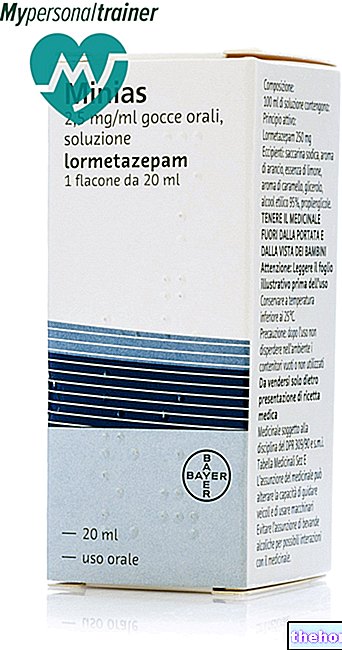Active ingredients: Trimebutin (trimebutin maleate), Medazepam
DEBRUM 150 mg + 4 mg HARD CAPSULES
Why is Debrum used? What is it for?
Pharmacotherapeutic group
Synthetic anticholinergic in association with psycholeptic.
Indications
Spastic-painful manifestations with an anxious component of the gastro-enteric system.
Contraindications When Debrum should not be used
Hypersensitivity to the active substances or to any of the excipients.
Contraindicated in the first three months of pregnancy (see "Pregnancy" and "Breastfeeding").
Myasthenia gravis.
Severe respiratory insufficiency.
Severe hepatic insufficiency.
Sleep apnea syndrome.
Precautions for use What you need to know before taking Debrum
When it is administered in high doses and for long periods of time, it is advisable to periodically monitor the trend of blood pressure values, blood count and liver function status.
Interactions Which drugs or foods can modify the effect of Debrum
Concomitant intake with alcohol should be avoided. The sedative effect may be enhanced when the medicinal product is taken in conjunction with alcohol. This adversely affects the ability to drive or use machines.
Association with CNS depressants: the central depressive effect may be enhanced in cases of concomitant use with antipsychotics (neuroleptics), hypnotics, anxiolytics / sedatives, antidepressants, narcotic analgesics, antiepileptics, anesthetics and sedative antihistamines. increase in euphoria leading to an increase in psychic dependence.
Compounds that inhibit certain liver enzymes (especially cytochrome P450) may increase the activity of benzodiazepines. To a lesser extent, this also applies to benzodiazepines which are metabolized only by conjugation.
Tell your doctor or pharmacist if you are taking or have recently taken any other medicines, even those without a prescription.
Warnings It is important to know that:
In general, the following warnings and precautions should be taken into account with the use of benzodiazepines.
Tolerance
Some loss of efficacy to the hypnotic effects of benzodiazepines may develop after repeated use for a few weeks. Dependence The use of benzodiazepines can lead to the development of physical and mental dependence on these drugs. The risk of dependence increases with dose and duration of treatment, and is greater in patients with a history of drug or alcohol abuse.
Once the physical dependence has developed, the abrupt termination of treatment will be accompanied by withdrawal symptoms.
These can consist of headache, body aches, extreme anxiety, tension, restlessness, confusion and irritability. In severe cases, the following symptoms may occur: derealization, depersonalization, hyperacusis, numbness and tingling of the extremities, hypersensitivity to light, noise and physical contact, hallucinations or seizures.
Rebound insomnia and anxiety: A transient syndrome in which symptoms that led to treatment with benzodiazepines recur in an aggravated form may occur on discontinuation of treatment. It may be accompanied by other reactions, including mood changes, anxiety, restlessness or disturbances As the risk of withdrawal or rebound symptoms is greater after abrupt discontinuation of treatment, a gradual decrease in dosage is suggested.
Duration of treatment
The duration of treatment should be as short as possible (see "Dose, method and time of administration") depending on the indication, but should not exceed four weeks for insomnia and eight to twelve weeks for anxiety, including a gradual withdrawal period. Extension of therapy beyond these periods should not occur without reassessment of the clinical situation. It may be helpful to inform the patient when treatment is started that it will be of limited duration and to explain precisely how the dosage should be progressively decreased. It is also important that the patient is informed of the possibility of rebound phenomena, thus minimizing anxiety about these symptoms should they occur when the drug is discontinued.
There is evidence that, in the case of benzodiazepines with a short duration of action, withdrawal symptoms may become manifest within administration between doses, particularly for high doses.
When using benzodiazepines with a long duration of action, it is important to warn the patient that abrupt change to a benzodiazepine with a short duration of action is not recommended, as withdrawal symptoms may occur.
Amnesia
Benzodiazepines can induce antegrade amnesia. This occurs most often several hours after ingestion of the drug and, therefore, to reduce the risk, it should be ensured that patients can have 7-8 hours of uninterrupted sleep (see "Side Effects").
Psychiatric and paradoxical reactions
When benzodiazepines are used, reactions such as restlessness, agitation, irritability, aggression, disappointment, anger, nightmares, hallucinations, psychosis, behavioral changes are known to occur. Should this occur, the use of the medicinal product should be discontinued.
Such reactions are more frequent in children and the elderly.
Specific groups of patients
Benzodiazepines should not be given to children without careful consideration of the actual need for treatment; the duration of treatment should be as short as possible. Elderly people should take a reduced dose (see "Dose, method and time of administration"). Likewise. , a lower dose is suggested for patients with chronic respiratory failure due to the risk of respiratory depression.
Benzodiazepines are not indicated in patients with severe hepatic insufficiency as they can precipitate encephalopathy. Benzodiazepines are not recommended for the primary treatment of psychotic illness. Benzodiazepines should not be used alone to treat depression or anxiety associated with psychotic illness. depression (suicide can be precipitated in such patients).
Pregnancy and breastfeeding
The product should not be administered in the first three months of pregnancy. In general, with the use of benzodiazepines during pregnancy or breastfeeding, it is good to know that:
- if the product is prescribed to a woman of childbearing age, she must contact her doctor, both if she intends to become pregnant, and if she suspects that she is pregnant, regarding discontinuation of the medicine;
- if, for serious medical reasons, the product is administered during the last period of pregnancy, or during labor at high doses, effects on the newborn may occur such as hypothermia, hypotonia and moderate respiratory depression due to the pharmacological action of the drug.
In addition, infants born to mothers who have taken benzodiazepines chronically during late pregnancy may develop physical dependence and may be at some risk of developing withdrawal symptoms in the postnatal period. Since benzodiazepines are excreted in breast milk, they should not be given to breastfeeding mothers.
In case of ascertained intolerance to some sugars, contact your doctor before taking this medicine. Ask your doctor or pharmacist for advice before taking any medicine.
Effects on ability to drive and use of machines
Sedation, amnesia, impaired concentration and muscle function can adversely affect the ability to drive and use machines. If sleep duration has been insufficient, the likelihood of impaired alertness may be increased (see "Interactions").
Dosage and method of use How to use Debrum: Dosage
2-4 capsules per day.
Senior citizens
In the treatment of elderly patients, the dosage should be carefully established by the doctor, who will have to evaluate a possible reduction of the dosages indicated above. If you have any further questions on the use of the medicinal product, ask your doctor or pharmacist.
Overdose What to do if you have taken too much Debrum
For the symptoms of overdose, which may possibly concern medazepam, any therapeutic measures common to all benzodiazepines must be applied. In case of accidental intake of an excessive dose of the medicine, notify your doctor immediately or go to the nearest hospital.
Side Effects What are the side effects of Debrum
Like all medicines, this can cause side effects, although not everybody gets them.
The following undesirable effects have been reported with the use of the drug: somnolence, arterial hypotension, confusion or locomotor disturbances with extrapyramidal symptoms are sometimes observed in certain patients, especially in elderly or debilitated subjects; these manifestations can be avoided by adjusting the dosage. .
Rarely, skin rashes, edema, nausea, constipation, visual disturbances may be observed. The very rare cases described of bone marrow depression with agranulocytosis, however usually reversible and of hepatic dysfunction, have not been reported with safety to the medazepam used.
The following undesirable effects have been reported with the use of benzodiazepines:
Somnolence (when the product is used as a hypnotic, it should be explicitly indicated: drowsiness during the day), dulling of emotions, decreased alertness, confusion, fatigue, headache, dizziness, muscle weakness, ataxia, double vision. These phenomena occur mainly at the beginning of therapy and usually disappear with subsequent administrations.
Other adverse reactions have occasionally been reported including: gastrointestinal disturbances, changes in libido and skin reactions.
Amnesia
Anterograde amnesia can also occur at therapeutic dosages, the risk increases at higher dosages. Amnesic effects may be associated with behavioral changes (see "Special Warnings").
Depression
A pre-existing depressive state may be unmasked during the use of benzodiazepines.
Benzodiazepines or benzodiazepine-like compounds can cause reactions such as: restlessness, agitation, irritability, aggression, delusion, anger, nightmares, hallucinations, psychosis, behavioral changes.
Such reactions can be quite severe. They are more likely in children and the elderly.
Dependence
The use of benzodiazepines (even at therapeutic doses) can lead to the development of physical dependence: discontinuation of therapy can cause rebound or withdrawal phenomena (see "Special warnings" and "Precautions for use"). Psychic dependence can occur.
Abuse of benzodiazepines has been reported.
Compliance with the instructions contained in this leaflet reduces the risk of undesirable effects.
If any of the side effects gets serious, or if you notice any side effects not listed in this leaflet, please tell your doctor or pharmacist.
Expiry and Retention
Expiry: see the expiry date indicated on the package.
The expiry date refers to the product in intact packaging, correctly stored.
Warning: do not use the product after the expiry date shown on the package.
Medicines should not be disposed of via wastewater or household waste. Ask your pharmacist how to throw away medicines you no longer use. This will help protect the environment.
KEEP THE MEDICINAL PRODUCT OUT OF THE REACH AND SIGHT OF CHILDREN
Composition and pharmaceutical form
Composition
One hard capsule contains:
Active ingredients: trimebutin maleate 150 mg, medazepam 4 mg.
Excipients: lactose monohydrate, mannitol, macrogol 6000, magnesium stearate, corn starch.
The capsule consists of: gelatin, iron oxide, titanium dioxide.
Pharmaceutical form and content
30 hard capsules.
Source Package Leaflet: AIFA (Italian Medicines Agency). Content published in January 2016. The information present may not be up-to-date.
To have access to the most up-to-date version, it is advisable to access the AIFA (Italian Medicines Agency) website. Disclaimer and useful information.
01.0 NAME OF THE MEDICINAL PRODUCT
DEBRUM
02.0 QUALITATIVE AND QUANTITATIVE COMPOSITION
Each hard capsule contains:
active principle:
• trimebutin maleate 150 mg
• medazepam 4 mg
For the list of excipients, see 6.1.
03.0 PHARMACEUTICAL FORM
Hard capsules.
04.0 CLINICAL INFORMATION
04.1 Therapeutic indications
Spastic-painful manifestations with an anxious component of the gastrointestinal tract.
04.2 Posology and method of administration
2-4 capsules per day.
Senior citizens: in the treatment of elderly patients, the posology must be carefully established by the doctor, who will have to evaluate a possible reduction of the dosages indicated above.
04.3 Contraindications
Hypersensitivity to the active substances or to any of the excipients.
Contraindicated in the first three months of pregnancy (see section 4.6).
Myasthenia gravis.
Severe respiratory insufficiency.
Severe hepatic insufficiency.
Sleep apnea syndrome.
04.4 Special warnings and appropriate precautions for use
The drug contains lactose therefore patients with rare hereditary problems of lactose intolerance, the Lapp lactase deficiency or glucose-galactose malabsorption should not take the medicine.
When it is administered in high doses and for long periods of time, it is advisable to periodically monitor the trend of blood pressure, blood count and liver function status.
In general, with the use of benzodiazepines, the following warnings and precautions must be taken into account:
Tolerance
Some loss of efficacy to the hypnotic effects of benzodiazepines may develop after repeated use for a few weeks.
Dependence
The use of benzodiazepines can lead to the development of physical and mental dependence on these drugs. The risk of dependence increases with dose and duration of treatment, and is greater in patients with a history of drug or alcohol abuse.
Once the physical dependence has developed, the abrupt termination of treatment will be accompanied by withdrawal symptoms.
These can consist of headache, body aches, extreme anxiety, tension, restlessness, confusion and irritability. In severe cases, the following symptoms may occur: derealization, depersonalization, hyperacusis, numbness and tingling of the extremities, hypersensitivity to light, noise and physical contact, hallucinations or seizures.
Rebound insomnia and anxiety: A transient syndrome in which symptoms that led to treatment with benzodiazepines recur in an aggravated form may occur on discontinuation of treatment. It may be accompanied by other reactions, including mood changes, anxiety, restlessness or disturbances As the risk of withdrawal or rebound symptoms is greater after abrupt discontinuation of treatment, a gradual decrease in dosage is suggested.
Duration of treatment
The duration of treatment should be as short as possible (see posology) depending on the indication, but should not exceed four weeks for insomnia and eight to twelve weeks for anxiety, including a gradual withdrawal period. "extension of therapy beyond these periods should not occur without re-evaluation of the clinical situation. It may be helpful to inform the patient when treatment is started that it will be of limited duration and to explain precisely how the dosage should be progressively decreased.
It is also important that the patient is informed of the possibility of rebound phenomena, thus minimizing anxiety about these symptoms should they occur when the drug is discontinued.
There is evidence that, in the case of benzodiazepines with a short duration of action, withdrawal symptoms may become manifest within administration between doses, particularly for high doses.
When using benzodiazepines with a long duration of action, it is important to warn the patient that abrupt change to a benzodiazepine with a short duration of action is not recommended, as withdrawal symptoms may occur.
Amnesia
Benzodiazepines can induce antegrade amnesia. This occurs most often several hours after ingestion of the drug and, therefore, to reduce the risk it should be ensured that patients can have 7-8 hours of uninterrupted sleep (see Side Effects).
Psychiatric and paradoxical reactions
When benzodiazepines are used it is known that reactions such as restlessness, agitation, irritability, aggression, disappointment, anger, nightmares, hallucinations, psychosis, behavioral changes can occur. Should this occur, the use of the medicinal product should be discontinued. These reactions are more frequent in children and the elderly.
Specific groups of patients
Benzodiazepines should not be given to children without careful consideration of the actual need for treatment; the duration of treatment should be as short as possible. The elderly should take a reduced dose (see posology). Likewise, a lower dose is suggested for patients with chronic respiratory insufficiency due to the risk of respiratory depression. Benzodiazepines are not indicated in patients with severe hepatic insufficiency as they can precipitate encephalopathies. Benzodiazepines are not recommended for the primary treatment of psychotic illness.
Benzodiazepines should not be used alone to treat depression or anxiety associated with depression (suicide can be precipitated in such patients). Benzodiazepines should be used with extreme caution in patients with a history of drug or alcohol abuse.
04.5 Interactions with other medicinal products and other forms of interaction
Concomitant intake with alcohol should be avoided. The sedative effect may be increased when the drug is taken in conjunction with alcohol. This adversely affects the ability to drive or use machines.
Association with CNS depressants: the central depressive effect may be enhanced in cases of concomitant use with antipsychotics (neuroleptics), hypnotics, anxiolytics / sedatives, antidepressants, narcotic analgesics, antiepileptics, anesthetics and sedative antihistamines. increase in euphoria leading to an increase in psychic dependence.
Compounds that inhibit certain liver enzymes (especially cytochrome P450) may increase the activity of benzodiazepines. To a lesser extent, this also applies to benzodiazepines which are metabolized only by conjugation.
04.6 Pregnancy and lactation
The product should not be administered in the first three months of pregnancy.
In general, with the use of benzodiazepines during pregnancy or breastfeeding, it is good to know that:
- if the product is prescribed to a woman of childbearing age, she must contact her doctor, both if she intends to become pregnant, and if she suspects that she is pregnant, regarding the suspension of the medicine;
- if, for serious medical reasons, the product is administered during the last period of pregnancy, or during labor at high doses, effects on the newborn may occur such as hypothermia, hypotonia and moderate respiratory depression due to the pharmacological action of the drug.
Additionally, infants born to mothers who have taken benzodiazepines chronically during late pregnancy may develop physical dependence and may be at some risk for developing withdrawal symptoms in the postnatal period. Since benzodiazepines are excreted in breast milk, they should not be given to breastfeeding mothers.
04.7 Effects on ability to drive and use machines
Sedation, amnesia, impaired concentration and muscle function can adversely affect the ability to drive and use machines. If sleep duration has been insufficient, the likelihood of impaired alertness may be increased (see interactions).
04.8 Undesirable effects
The following undesirable effects have been reported with the use of the drug: somnolence, arterial hypotension, confusion or locomotor disturbances with extrapyramidal symptoms are sometimes observed in certain patients, especially in elderly or debilitated subjects: these manifestations can be avoided by adjusting the dosage. .
Rarely, skin rashes, edema, nausea, constipation, visual disturbances may be observed.
The very rare cases described of bone marrow depression with agranulocytosis, however usually reversible and of hepatic dysfunction, have not been reported with safety to the medazepam used.
The following undesirable effects have been reported with the use of benzodiazepines: snnolence (when the product is used as a hypnotic, it should be explicitly indicated: drowsiness during the day), dulling of emotions, decreased alertness, confusion, fatigue, headache, dizziness , muscle weakness, ataxia, double vision. These phenomena occur mainly at the beginning of therapy and usually disappear with subsequent administrations.
Other adverse reactions have occasionally been reported including: gastrointestinal disturbances, changes in libido and skin reactions.
Amnesia
Anterograde amnesia can also occur at therapeutic dosages, the risk increases at higher dosages. Amnesic effects may be associated with behavioral changes (see special warnings and precautions).
Depression
A pre-existing depressive state may be unmasked during the use of benzodiazepines.
Benzodiazepines or benziodiazepine-like compounds can cause reactions such as: restlessness, agitation, irritability, aggression, delusion, anger, nightmares, hallucinations, psychosis, behavioral changes.
Such reactions can be quite severe. They are more likely in children and the elderly.
Dependence
The use of benzodiazepines (even at therapeutic doses) can lead to the development of physical dependence: discontinuation of therapy can cause rebound or withdrawal phenomena (see special warnings and precautions). Psychic dependence can occur.
Abuse of benzodiazepines has been reported.
04.9 Overdose
For the symptoms of overdose, which may possibly concern medazepam, any therapeutic measures common to all benzodiazepines must be applied.
05.0 PHARMACOLOGICAL PROPERTIES
05.1 Pharmacodynamic properties
ATC: A03CA49 synthetic anticholinergics in association with psycholeptics.
DEBRUM is a "combination of trimebutin and medazepam. Trimebutin is a synthetic drug with an elective action on the myenteric plexuses of the alimentary canal that normalizes impaired motility in both hypokinesia and hyperkinesia states. Since it is devoid of anticholinergic activity it does not cause atony. visceral and does not modify digestive secretions: therefore it does not in any way alter the physiological phenomena of digestion.
Medazepam is a benzodiazepine derivative with a prevalent action on the limbic system, integrating center of the affective and emotional tone. Medazepam has a remarkable anxiolytic activity.
05.2 Pharmacokinetic properties
TRIMEBUTINA
Absorption
Studies with the labeled molecule have shown an elective impregnation in those areas of the gastro-enteric system where the autonomic nervous plexuses of Meissner and Auerbach are present.
Distribution
The impregnation is rapid and lasting (after one hour it is maximum at the esophageal level, after three hours at the gastric level and after six hours at the intestinal level - small and large intestine).
Elimination
The molecule is eliminated in the form of various metabolites in the urine in the ratio of 85% within 24 hours of administration.
MEDAZEPAM
Absorption
Absorbed in the gastrointestinal tract, maximum plasma rate 1 to 3 hours after oral administration.
Breakdown
High binding to plasma proteins.
Half-life
Elimination half-life between 2 and 5 hours.
Metabolism
Hepatic metabolism: among the metabolites diazepam and oxazepam.
Elimination
60% of the dose is eliminated by the kidney mainly in the form of glucuroconjugated oxazepam. 22% of the dose is eliminated in the faeces.
05.3 Preclinical safety data
Acute toxicity
Oral LD50 in mice and rats over 2000 mg / kg for trimebutin, and over 1000 mg / kg for medazepam; via i.p. in rats it is 425 mg / kg for trimebutin and 215 mg / kg for medazepam; in mice, 405 mg / kg for trimebutin and 340 mg / kg for medazepam.
Chronic toxicity
Studied in rats and rabbits with oral treatment lasting 25 weeks, toxic alterations and variations in the biological parameters examined have never appeared, furthermore there have never been any anatomical or functional changes of the various organs, nor alterations of normal fetal development. and embryonic.
06.0 PHARMACEUTICAL INFORMATION
06.1 Excipients
Lactose monohydrate, mannitol, macrogol 6000, magnesium stearate, corn starch.
The hard capsule consists of: gelatin, iron oxide, titanium dioxide.
06.2 Incompatibility
Not known.
06.3 Period of validity
5 years.
06.4 Special precautions for storage
They are not necessary.
06.5 Nature of the immediate packaging and contents of the package
Box of 30 hard capsules, in blisters of 150 mg of trimebutin maleate and 4 mg of medazepam.
06.6 Instructions for use and handling
No special instructions.
07.0 MARKETING AUTHORIZATION HOLDER
Sigma-Tau Industrie Farmaceutiche Riunite S.p.A.
Viale Shakespeare, 47 - 00144 Rome
Dealership for sale:
BIOFUTURA PHARMA S.p.A.
Via Pontina km 30,400 - 00040 Pomezia (Rome)
08.0 MARKETING AUTHORIZATION NUMBER
Hard capsules 150 mg of trimebutin maleate and 4 mg of medazepam - A.I.C. n. 023446014
09.0 DATE OF FIRST AUTHORIZATION OR RENEWAL OF THE AUTHORIZATION
Authorization: November 1976
Renewal: June 2005
10.0 DATE OF REVISION OF THE TEXT
November 2007




























